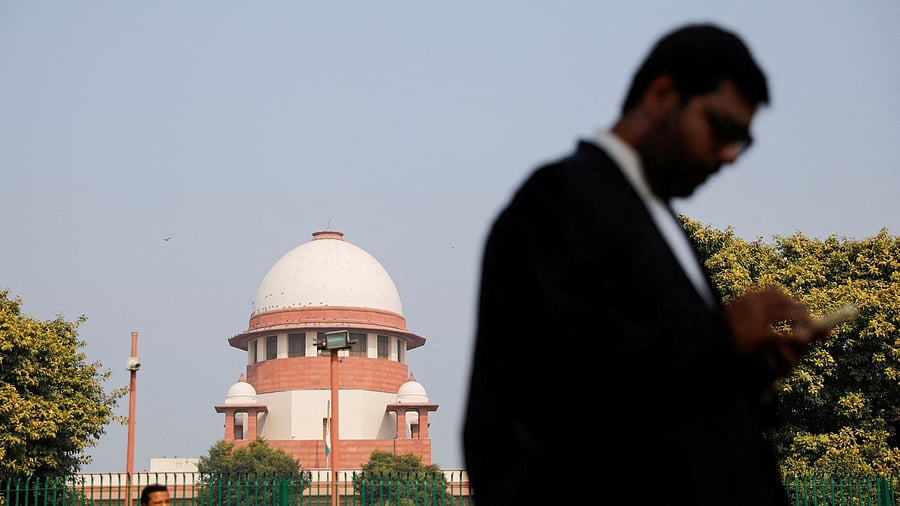
A lawyer looks into his mobile phone in front of India's Supreme Court
Credit: Reuters File Photo
New Delhi: The Supreme Court on Wednesday said the failure of the eyewitnesses to identify the accused in the court as the one they had seen committing the crime is fatal to the prosecution's case.
Holding that identification of the accused sitting in the court by the eyewitness is of utmost importance, the top court acquitted two persons in a double murder case of 2001.
A bench of Justices Abhay S Oka, Pankaj Mithal and Ahsanuddin Amanullah allowed the appeal of Tukesh Singh and another person, represented by senior advocate Sidharth Luthra, who challenged the Chhattisgarh High Court's judgment of September 10, 2010. The HC upheld the conviction of the appellants and seven others by the trial court, which awarded them life imprisonment.
According to the prosecution, on March 23, 2001, following a property dispute, the accused, with a common object, armed with deadly weapons like sword, rod, knife, poleaxe, club, etc. went to the disputed shop and murdered Manrakhan Singh and Narayan Singh and attempted to kill Shivraj Singh, Virendra Singh, Judawan Singh, Visheshwar Singh Thakur and Rakesh Singh Thakur. These were the injured eyewitnesses.
Considering the appeal, the bench noted, in this case, the failure of the eyewitnesses to identify the accused in the court as the accused they had seen committing the crime is fatal to the prosecution's case.
"There were material omissions brought on record in the cross-examination of the eyewitnesses. They are so relevant that the same constituted contradictions in view of the explanation to Section 162 of the Code of Criminal Procedure, 1973," the court said.
The court held the guilt of the accused has not been proved beyond a reasonable doubt as the version of the eyewitnesses differed. The appellants-accused, before they were enlarged on bail, had undergone a minimum of nine to ten years of actual sentence. They were on bail for about 12 years.
Dealing with the larger issue, the bench said, "In a case where there are eyewitnesses, one situation can be that the eyewitness knew the accused before the incident. The eyewitnesses must identify the accused sitting in the dock as the same accused whom they had seen committing the crime."
It pointed out another situation can be that the eyewitness did not know the accused before the incident. "In the normal course, in case of the second situation, it is necessary to hold a Test Identification Parade. If it is not held and if the evidence of the eyewitness is recorded after a few years, the identification of such an accused by the eyewitness in the court becomes vulnerable. Identification of the accused sitting in the court by the eyewitness is of utmost importance," the court emphasised.
Giving an example, the bench said, "If an eyewitness states in his deposition that he had seen A, B and C killing X and he knew A, B and C, such a statement in the examination-in-chief is not sufficient to link the same to the accused."
"The eyewitness must identify the accused A, B and C in the court. Unless this is done, the prosecution cannot establish that the accused are the same persons who are named by the eyewitness in his deposition. If an eyewitness states that he had seen one accused assaulting the deceased with a sword, another accused assaulting the deceased with a stick and another accused holding the deceased to enable other accused to assault the deceased, in such a case, the eyewitness must identify the accused in the open court who, according to him, had assaulted the accused with a stick, who had assaulted the deceased with a sword and who was holding the deceased. Unless the eyewitnesses identify the accused present in the court, it cannot be said that, based on the testimony of the eyewitnesses, the guilt of the accused has been proved," the bench said.
